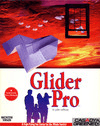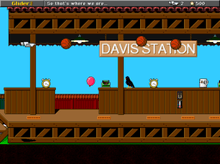Glider PRO
 | |
| Original author(s) | Casady & Greene |
|---|---|
| Developer(s) | John Calhoun |
| Initial release | 1994 |
| Stable release |
1.1.2
/ 1995 |
| Operating system | Mac OS, Mac OS X |
| Available in | English |
| Type | Arcade |
Glider PRO is an Apple Macintosh game designed by John Calhoun and first published by Casady & Greene in 1994. Calhoun originally distributed a Glider game as shareware under the name Soft Dorothy Software before producing the Glider 4.0 and Glider PRO games that were to be commercially published.[1] When Casady & Greene went bankrupt in 2003,[2] the rights to the series reverted to the author, who opted for a period of time to give a few versions of the game away for free on his website.[3]
The game
Game basics

In the game, you fly a paper plane (the Glider) in, around, over and even under a house trying to collect a number of hidden magic stars. The Glider can only be maneuvered to glide forward, glide backward, or to stand still. Further navigation is done chiefly with the aid of air currents provided by floor or ceiling ventilation ducts, fans, drafts, and wind. It is also possible to slide along slippery surfaces (such as spilled grease), and transport from a part of the level to another using the ventilation system, mailboxes, and sometimes invisible "teleports".
The main challenge is to simply avoid collision with the floor, or obstacles such as furniture. Moving obstacles include bouncing basketballs, popping toast, and dripping water. Candles and other ablaze objects sport both a handy updraft and a lethal flame. Collision with "enemy" paper planes and balloons is also fatal, but these can be shot down with the use of a rubber bands bonus item. The other bonus items are aluminum foil (shielding against in-flight collisions), pieces of paper (extra lives), a variety of clocks (points) and batteries and helium tanks (mutually exclusive, granting the ability for faster or more buoyant flight, respectively).
A puzzle element is added to the gameplay in the form of switches controlling vents, lighting, home applications and even enemies.
Unlike the Glider 4.0 game, in which the game metaphor involved such things as claustrophobia and rainy days indoors, the metaphor in the Glider PRO game involves such things as sunny weather, the start of summer vacation, and outdoor environments in addition to indoor environments.[4]
Houses
Levels are called "houses", although a level may contain any number of individual buildings, as well as outdoors, sewer, or other sections. Houses are entirely self-contained, and any of them is immediately available for play. The game was released with one real house called Slumberland, and one demonstration house. A later CD release of the game featured 14 further houses. Beyond this, a sizable number of houses are available for download on fan sites.
Reception
| Reception | ||||||
|---|---|---|---|---|---|---|
| ||||||
Inside Mac Games praised the game for its entertaining and non-violent gameplay, in addition to having a two-player mode that did not require modems or a network.[6]
Versions of the game
Differences between OS X/Carbon and System 7-OS 9/Classic versions
Glider PRO was initially released for System 7 and was continuously updated through a Mac OS 9 version, the final release on the "Classic" Mac OSes. It was later ported to Mac OS X as a native Carbon application, and while this version has reworked graphics and a more muted color scheme it lacks a variety of preferences and the built-in house editor present in the Mac OS 9 version. PowerPC Mac OS X users can still run the Mac OS 9 version of Glider in the Classic environment, giving them access to the multitude of additional preferences and the house editor.
Glider PRO ("Classic") CD
This was an update that included Glider PRO, new houses, and a few utilities. The houses included were Art Museum, In the Mirror, Davis Station, Castle o' the Air, Teddy World, Land of Illusion, Imaginehouse PRO II, The Asylum PRO, Nemo's Market, Titanic, SpacePods, Rainbow's End, Leviathan, Grand Prix, Metropolis, and obviously Slumberland, Empty House and Demo House. In addition, the utilities Moving Van, a utility for moving graphics and sound between houses and libraries and any combination of the two, and Foundation Mover, a utility for sliding an entire house over in terms of the map position if you room ran out and CD-ROM special instructions and some graphics libraries were included.
House building
Houses are created using the built-in house editor in the "Classic" version. Standard backgrounds include rooms of many decors, from Asian tapestry to a personal library, as well as meadows, fields and gardens; sewers and basements; rooftops and open skies. There is also a wide selection of furniture, other obstacles, and background items ("clutter"), all of which are demonstrated by "Slumberland". Enemy design is limited to specifying attack range and timing.
Customizing
Glider PRO allows for houses to include custom backgrounds, objects and sounds via embedding of 'PICT', 'STR#' and 'snd' resources in the house's resource fork. A few of the game's existing interface elements can also be altered this way. Most houses, including all that shipped with the game, do include at least custom graphics. An interesting design point is that custom objects are on their own purely background elements, but can be made interactive with the help of the game's many different invisible objects.
Fans have exploited design bugs as well as constructed patches to alter houses and/or the program itself even further; the extreme makeover remains Ward Hartenstein's "house" SeaCaves, which completely renews the game into an undersea adventure of a dolphin to free a magical starfish.
A debugging feature in the Mac OS 9 version of Glider PRO allows all of the graphics and sounds in the game (including the ones that cannot be directly replaced by a house's resource fork) to be overridden by alternative graphics. This is done by placing a file named "Mermaid", containing all of the replacement graphics and sounds, in the same directory as the Glider PRO application. This feature was forgotten about by the time Glider PRO was released, but John Calhoun later rediscovered it in April 2004. As of today, at least three houses exist that exploit this feature.
The word "Mermaid" was used as a reference to three lines from the poem The Love Song of J. Alfred Prufrock:
- "We have lingered in the chambers of the sea
- By sea-girls wreathed with seaweed red and brown
- Till human voices wake us, and we drown."
The first of these lines also appears in the About box of Glider PRO.
Community and future of Glider series
Probably due to its House-creating ability, Glider PRO has enjoyed an active and involved fan community during most of its life. Two monthly ezines, GliderTech and The Cockpit were published between 1995 and 1997 during Glider PRO's heyday. GliderTech published editorials, house reviews, house building tips and each issue was accompanied by a house or two with some examples of obstacles or techniques that could be used in house creation. Past issues can be found for download on various house repositories, and the actual zine is an OS 9 application.
In 2006, Mark Arenz teamed up with Calhoun to construct Glider Web, an Internet-enabled version of Glider Pro built in Flash.
On 20 June 2014, a version of Glider for OS X 10.7 or later, was released on the Mac App Store. This version is also available for the iPhone and iPad as "Glider Classic."[7] Both are from Soft Dorothy LLC.
On 27 Jan 2016, the source code, graphics, and sound data for Glider PRO were released on GitHub with the source code being licensed under the GNU General Public License v2.[8][9][10]
References
- ↑ Klimas, Chris (2004-05-10). "Talking with John Calhoun (part 2)". Crunchable. Retrieved 2016-03-16.
- ↑ Sellers, Dennis (2003-06-30). "Casady & Greene to cease operations Thursday". MacWorld. Archived from the original on 2007-06-08.
- ↑ Calhoun, John. "Glider PRO". Archived from the original on 2012-05-16. Retrieved 2016-03-16.
- ↑ McCornack, Jamie; et al. (1995). Tricks of the Mac Game Programming Gurus. Hayden Books. p. 713. ISBN 978-1-56830-183-9.
- ↑ Mark Clarkson (January 1995). "Computer Gaming World - Issue 126" (126): 182.
A Spunky Little Flyer Catches Thermal In GLIDER PRO
- ↑ Myrick, Chris (December 1994). "Review: Glider Pro". Inside Mac Games (free preview edition). 2 (12).
- ↑ Patterson, Blake (2011-09-26). "John Calhoun's Mac Classic 'Glider' Coming to iOS". Touch Arcade. Retrieved 2014-10-10.
- ↑ Nutt, Christian (2012-02-16). "Get a window into classic Mac dev with Glider source code". Gamasutra. Retrieved 2016-08-02.
- ↑ Calhoun, John (2016-01-29). "Sources for the Macintosh game, Glider PRO, written by John Calhoun and published by Casady & Green Inc.". GitHub.
- ↑ Calhoun, John (2016-01-31). "Added legal section to read me. · softdorothy/glider_pro@49a35bb · GitHub". GitHub. Retrieved 2016-03-16.